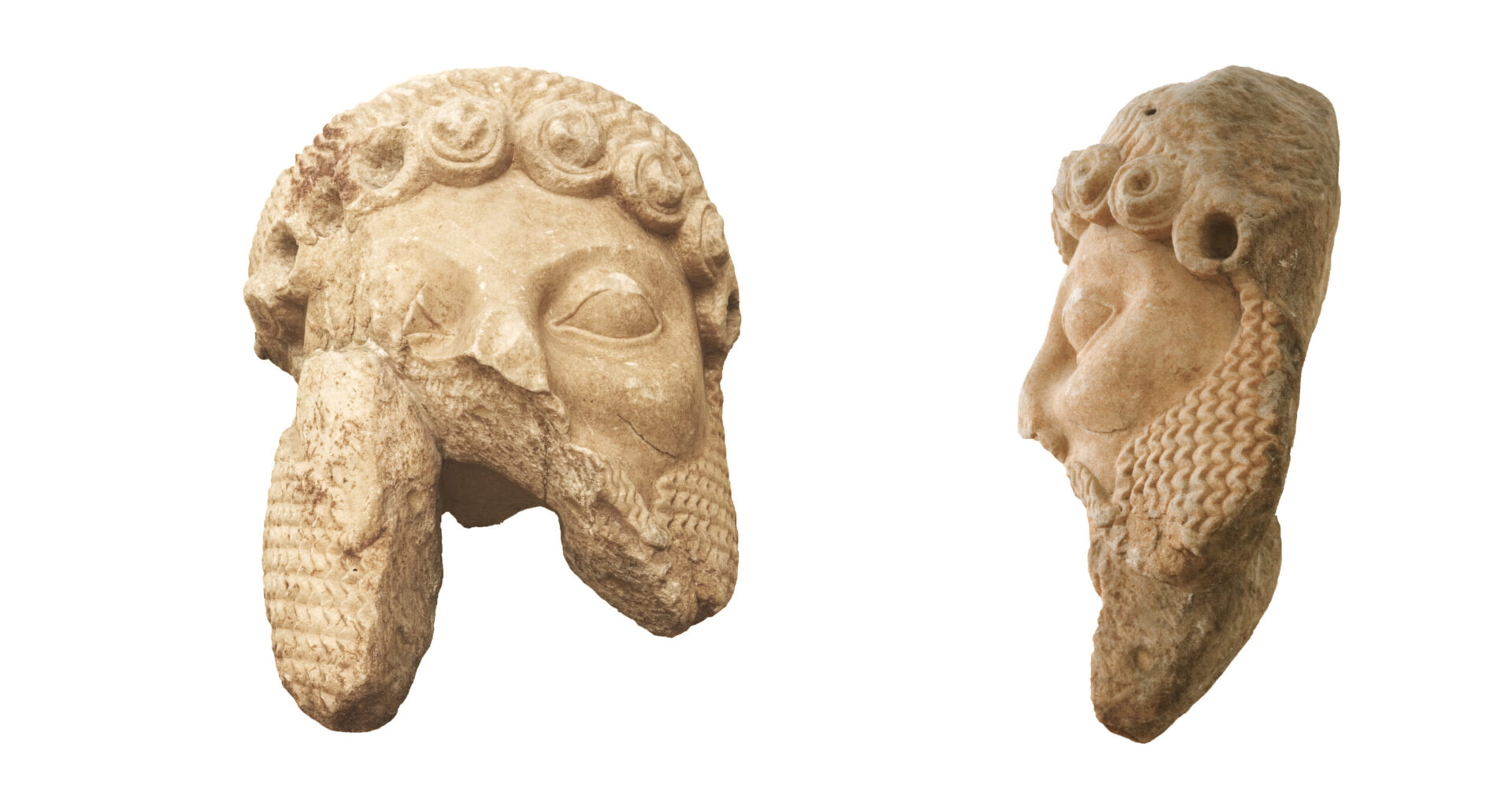Exhibit of the month
The face as object of worship
Marble head of Dionysos
National Archaeological Museum
Sculpture Collection, inv. no. Γ 3072
Provenance: Discovered in 1888 during the excavations carried out by the American School of Classical Studies in the ancient deme of Ikaria or Ikarion, modern Dionysos, in Attica.
Dimensions: Height 44.2 cm
Date: 530-520 BC
Display location: Room 13
Preserved is the upper part of the colossal face and the lower right part of the beard, which have been mended. Thick, snail-shell curls are antithetically twisted over the forehead. The figure must have worn a metal wreath, indicated by the drilled holes above the curls.
The marble head, characterised by strong asymmetries, originally belonged to the Archaic seated statue of Dionysos ΕΑΜ Γ 3897, together with which it is now exhibited in the National Archaeological Museum. It was later reworked into a mask which would have hung on a wooden pole serving as a second cult statue in the Ikarion sanctuary[1], dedicated to the same god in his capacity as Dendrites. Dionysos Dendrites, god of trees and plants, is the patron of cultivation, especially viticulture.
According to the interpretation given by Professor Giorgos Despinis, the conversion of the head into a mask of Dionysos is linked to the collapse of the marble baldachin of the statue, which damaged the back of the head, probably during the second half of the 4th century BC[2].
This was then chiseled off and a cutting for a big horizontal dowel for hanging was added to it. New snail-shell curls were also inserted over the forehead.
Cultic or votive terracotta masks of Dionysos are encountered in Boeotia and Attica already at the end of the 6th century BC, while marble specimens from Marathon, the Athenian Agora and the Acropolis are dated to the Early Classical period. On the so-called Lenaia vases, associated with the Lenaia, the Anthesteria or some other Dionysiac festival in Athens, the god’s mask is attached to a tree, pillar or column usually wrapped in a garment. This creates the image of a xoanon taking part in the cultic rituals. Literary sources also refer to early Archaic masks of Dionysos made of wood or plaster, which were worshiped as xoana.
[1] Ikarion was the legendary site of the first arrival of Dionysos in Attica and it is connected to the introduction of viticulture and the birth of ancient Greek tragedy and comedy. It was here that the local hero Ikarios hospitably received Dionysos, who in turn taught him viticulture and wine making. From Ikarion came Thespis, the first tragic poet, who introduced actors and masks in the Dionysian dithyramb, thus laying the foundations of ancient tragedy in the 6th c. BC.
[2] Repairs and renovations at the sanctuary and the cult statue of Dionysos are known to have taken place in the 4th century BC (IG II2 2851). The head, and possibly also other parts of the statue, seem to have been replaced or repaired.
Dr Eurydice Leka
Bibliography (in chronological order)
C.D. Buck, Discoveries in the Attic Deme of Ikaria, 1888. VIII. Sculptures, AJA 5 (1889) pp. 461-477.
W. Wrede, Der Maskengott, AM 53 (1928) pp. 66-95.
D. Willers, Zu den Anfängen der archaistischen Plastik in Griechenland (Berlin 1975) pp. 33-47.
I. Bald Romano, The Archaic Statue of Dionysos from Ikarion, Hesperia 51 (1982) pp. 398-409.
F. Frontisi-Ducroux, Le dieu-masque. Une figure du Dionysos d’Athènes (Paris 1991).
Ο. Τζάχου-Αλεξανδρή, Απεικονίσεις των Ανθεστηρίων και ο χους της Οδού Πειραιώς του ζωγράφου της Ερέτριας, in: J. Oakley – W. D. E. Coulson – O. Palagia (eds.), Athenian Potters and Painters (Oxford 1997) pp. 473-490.
S. Schmidt, Rhetorische Bilder auf attischen Vasen. Visuelle Kommunikation im 5. Jhd v. Chr. (Berlin 2005) pp. 184-186.
G. Despinis, Neues zu der spätarchaischen Statue des Dionysos aus Ikaria, AM 122 (2007) pp. 103-137.
G. Despinis – Ν. Kaltsas (eds.), Εθνικό Αρχαιολογικό Μουσείο. Κατάλογος γλυπτών, Ι.1. Γλυπτά των αρχαϊκών χρόνων από τον 7ο αιώνα έως το 480 π.Χ. (Athens 2014) pp. 221-223, no. Ι.1. 198, figs. 706-709 (G. Despinis).


